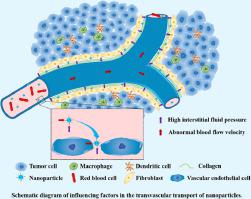Computer Methods and Programs in Biomedicine ( IF 4.9 ) Pub Date : 2020-05-05 , DOI: 10.1016/j.cmpb.2020.105493 Yan Gao 1 , Yanbin Shi 1 , Mengguang Fu 1 , Yihua Feng 1 , Guimei Lin 2 , Deyin Kong 1 , Bo Jiang 1

|
Background and objective
Although nanoparticle preparations have great potential in the treatment of tumors, nanoparticle preparations have not achieved the desired therapeutic effect. The reason is that the abnormal tumor microenvironment prevents nanoparticles from effective concentrating and reaching tumor area. Therefore, it's very necessary to better understand the effect of the abnormal tumor microenvironment on the transvascular transport of nanoparticles to overcome this critical problem.
Methods
In this paper, a tumor abnormal vascular-interstitial model was established, and the transvascular transport process of nanoparticles was simulated in the model by computational fluid dynamics (CFD) modeling.
Results
The simulation results showed that the transport efficiency of nanoparticles decreased with increasing interstitial fluid pressure (IFP), and nanoparticles could not cross the blood vessel wall when the IFP approached the blood vessel wall pressure. Interestingly, the transport efficiency of nanoparticles first increased with blood flow velocity, and then decreased with blood flow velocity.
Conclusions
The results showed that with the continuous malignant development of tumors, the ability of nanoparticles to passively diffuse has almost disappeared. The enhanced permeability and retention (EPR) effect of the nanoparticles disappeared with the disappearance of the pressure gradient inside the tumor. These results provided guidance for future research on the vascular transport pathways and mechanisms of nanoparticles.
中文翻译:

间质液压力和血流速度对肿瘤微环境中纳米颗粒经血管转运影响的模拟研究。
背景和目标
尽管纳米颗粒制剂在治疗肿瘤方面具有巨大潜力,但是纳米颗粒制剂尚未获得所需的治疗效果。原因是异常的肿瘤微环境阻碍了纳米颗粒的有效富集并到达肿瘤区域。因此,有必要更好地了解异常的肿瘤微环境对纳米颗粒跨血管运输的影响,以克服这一关键问题。
方法
本文建立了肿瘤异常的血管间质模型,并通过计算流体动力学(CFD)模型模拟了纳米颗粒的跨血管运输过程。
结果
仿真结果表明,纳米颗粒的传输效率随组织液压力(IFP)的增加而降低,而当IFP接近血管壁压力时,纳米颗粒不能穿过血管壁。有趣的是,纳米颗粒的传输效率首先随血流速度增加,然后随血流速度降低。
结论
结果表明,随着肿瘤的不断恶性发展,纳米粒子的被动扩散能力几乎消失了。随着肿瘤内部压力梯度的消失,纳米颗粒的增强的渗透性和保留(EPR)效果消失了。这些结果为纳米颗粒的血管运输途径和机理的进一步研究提供了指导。











































 京公网安备 11010802027423号
京公网安备 11010802027423号